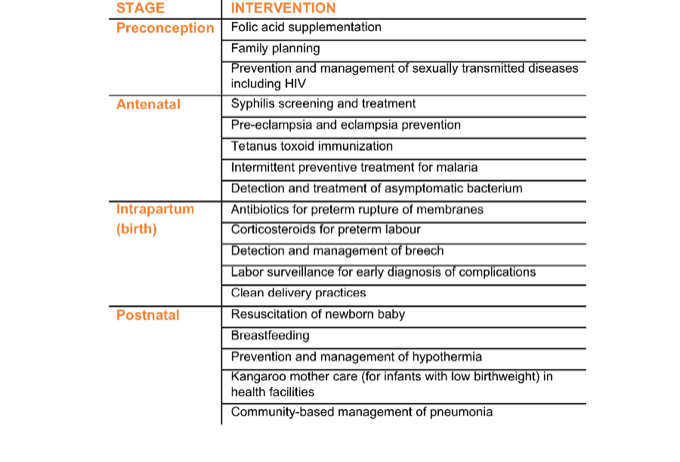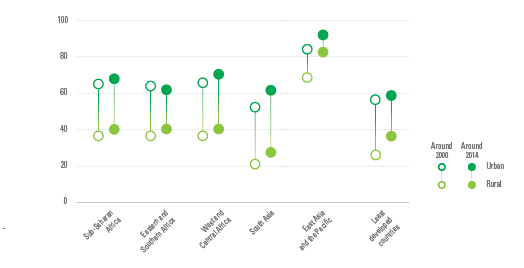The boundaries and names shown and the designations used on this map do not imply official endorsement or acceptance by the United Nations. Final boundary between the Republic of Sudan and the Republic of South Sudan has not yet been determined.
*Dotted line represents approximately the Line of Control in Jammu and Kashmir agreed upon by India and Pakistan. The final status of Jammu and Kashmir has not yet been agreed upon by the parties.
The first month of life: the most vulnerable period
Death in the first month of life, which is usually preventable, represents a substantial share of total deaths among children under five. As mortality among children under-five decline globally, deaths among these children are more and more concentrated in the first days of life. This makes focus on newborn care critical than ever before. In 2013, an estimated 2.8 million children died in their first month of life; 1 million or 36 per cent died in the first day of life. Neonatal deaths represent 44 per cent of all deaths among children under 5 worldwide that year. Despite ongoing challenges, major progress has been made in improving neonatal survival. Neonatal mortality is on the decline globally. The world’s neonatal mortality rate fell from 33 deaths per 1,000 live births in 1990 to 20 per 1,000 in 2013, a 40 per cent decline. The overall result was a reduction in neonatal deaths worldwide from 4.7 million in 1990 to 2.8 million in 2013.
The large majority of newborn deaths (79 per cent) is due to preterm delivery or complications during childbirth, along with sepsis and pneumonia. Thus, targeting the time around birth will prevent up to 80 per cent of newborn deaths. The "Every Newborn Action Plan" (ENAP) calls for an increased focus on the time around birth with targeted high impact interventions as a strategy for reducing not only newborn deaths but also maternal deaths and stillbirths, generating a triple return in the investment.
LIFE-SAVING INTERVENTIONS FOR THE NEWBORN
The interventions needed to save newborn from dying from preventable causes are simple, affordable and based on evidence. Ending preventable maternal and newborn deaths requires quality care along the continuum of care, starting from preconception interventions such as maternal micronutrient supplementation, family planning and prevention and management of sexually transmitted diseases. It continues through quality skilled antenatal, labour and delivery and postnatal care. The greatest impact on newborn survival is obtained through care during labour, childbirth and the first week of life, and care for the small and sick newborn.
SKILLED DELIVERY AND POSTNATAL CARE
Skilled care at birth and postnatal checkups are essential to the well-being of both mother and newborn. Quality skilled care at birth would ensure that the newborn receives essential newborn care including thermal and cord care, and immediate breastfeeding. It also increase access to emergency care in the event of life-threatening complications. A newborn who is not breathing at birth will die within minutes if not properly cared for. However, just two-third of births in 2013 (68 per cent) were delivered by a skilled health personnel. The rate is even lower in least developed countries where only 46 per cent of births had the benefit of skilled attendance at delivery.
Newborns are most vulnerable during the first hours and days of life, yet this critical window of opportunity is being missed. Data indicate that in least developed countries, only about half (54 per cent) of newborn are weighed at birth and similar proportion (53 per cent) initiate breastfeeding immediately after birth.
The postnatal period is the time following delivery until six weeks after birth, and health checks during this time – especially the first two days after delivery – can be critical. The WHO recommends postnatal care within 24 hours of birth, regardless of where the baby is born. Mothers and newborns should receive at least three additional postnatal care visits by a skilled provider, ideally on day 3 (48–72 hours after birth), between day 7 and day 14, and again 6 weeks after birth.
Postnatal care for the baby is an important opportunity to check for danger signs, such as insufficient feeding, fast breathing (a breathing rate of more than 60 per minute), severe chest in-drawing, lethargy, fever, low body temperature, or jaundice. At the same time, mothers can receive advice on how to identify and respond to these symptoms, as well as the benefits of exclusive breastfeeding and immunization.
Given the critical importance of essential newborn care and postnatal care for the baby, household survey programs such as DHS and MICS have recently included indicators to track the coverage of this important component of care for mothers and newborns. In the limited number of countries with data, only about half of mothers and newborns receive postnatal care, with significant variations across countries. In many of these countries data on newborn care are still lacking.
HOME VISITS FOR NEWBORN CARE
A key strategy for ensuring a continuum of care from pregnancy through early childhood is integrating interventions in community-based programs and linking them to other services within health systems. In addition to the key interventions described above, adequate nutrition for pregnant and nursing women is essential to the well-being of both mother and child. The World Health Organization (WHO) and UNICEF recommend that care be provided by a skilled attendant during and immediately after birth, irrespective of where the birth takes place. When appropriate, home visits can provide effective care to infants and increase newborn survival. This strategy has shown positive results in high-mortality settings by improving essential newborn care practices and reducing newborn mortality.
REFERENCES
The Lancet Neonatal Survival Series, March 2005.
UNICEF, Committing to Child Survival: A promise renewed – Progress report 2013, UNICEF, New York 2013.
UNICEF’s Multiple Indicator Cluster Surveys, Rounds 4 and 5, UNICEF, New York, 2013.
UNICEF, The State of the World’s Children 2014, UNICEF, New York, 2014.
United Nations Inter-agency Group for Child Mortality Estimation (IGME), Levels and Trends in Child Mortality: Report 2013, UNICEF, New York, 2013.
WHO/UNICEF Joint Statement, Home Visits for the Newborn Child: A strategy to improve survival, WHO, Geneva, 2009.






